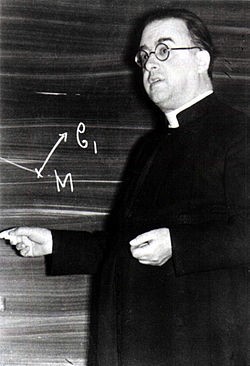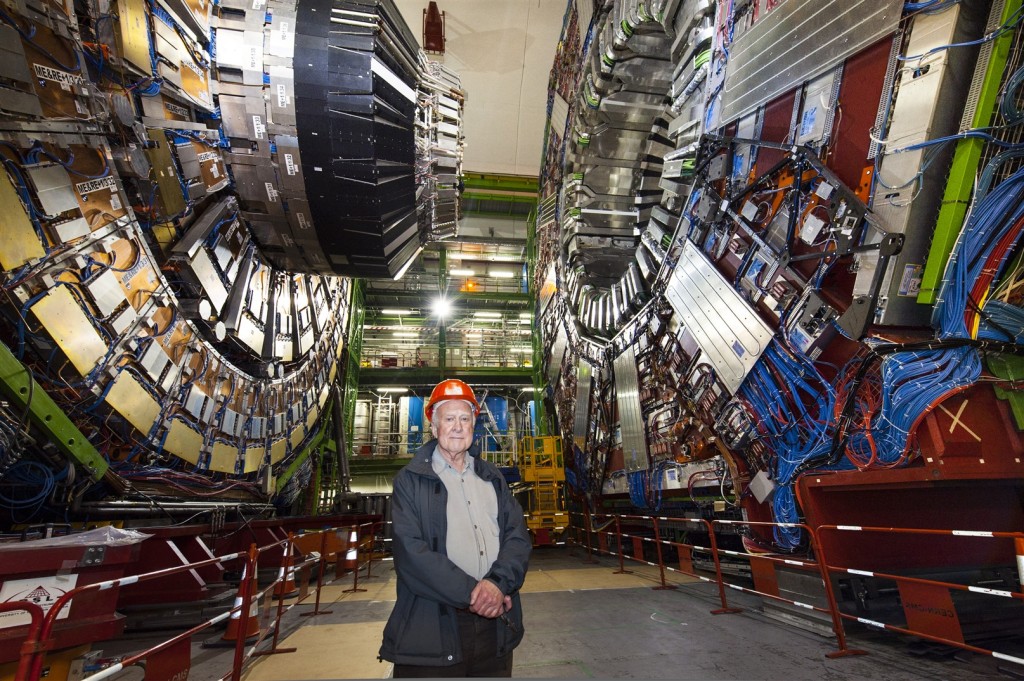—the danger of compromise with paganism

Recently a YEC biblical creationist friend wrote me with a proposal in relation to a biblical creationist discussion group’s consideration about how the big bang cosmology proposed by Abbott Georges Lemaître might be applicable to creationist cosmology.
1
7 Reasons to reject Lemaître

I see you are interested in and discussing Lemaître’s cosmology. I assume you are interested in it from the point of view of adapting it to a YEC creation scenario. But I would caution you to consider the following.
- Lemaître was Jesuit educated. The Jesuits had/have only one purpose, to destroy the Word of God and the protestant Reformation. The Jesuits adopted a policy of “to put learning against learning,” which means to destroy the foundations of the true church through an insidious misinformation agenda. Producing a big bang model that had only a deist type god starts it off and after that had nothing to do with the creation undermines the Genesis account and thus the whole biblical text.
- Lemaître’s model was pagan, not Christian nor creationist. At best it was deist. But the Romish church and especially the Jesuits promoted and promote a humanist pagan agenda. Read The big bang is pagan philosophy; it is not science. Jesuit’s take an oath that requires them to do anything to protect and restore the Church of Rome and the Papacy. That is the environment (at least) that he was trained under. If he was a Jesuit, in fact, that oath alone would guarantee that he was not a true born-again believing Christian. And that means his cosmological model in no way could have been inspired by the Holy Spirit. The Holy Spirit will lead us into all truth (John 15:26), but the big bang can only lead us away from historical accuracy of the Word of God.
- You might argue the genetic fallacy, and that Alexander Friedmann developed the same idea independently. But that argument fails, because it could mean Satan gave the same idea to two different agents independently. Satan challenged Eve in the Garden “Has God not said?” He planted the evil thought. Besides in philosophy, metaphysics and religion etc it is worth examining the genetics of ideas as they have great bearing on their validity. For example, Karl Marx’s belief system produced the communist philosophy that the Jesuits embraced in the form of national socialism and Adolf Hitler (an Austrian Catholic). There is even some evidence that a Jesuit actually wrote ‘Mein Kampf.’

- Friedmann was an atheist, and saw no creator in his big bang cosmology, which is mathematically identical to Lemaître’s. Lemaître’s may have started cold and involves a finite universe, with a deistic god as the originator, but after that it was all nature, no Creator. And the accelerating expansion was always in all big bang models, including Friedmann’s. It depends on the mass density of the Universe. For about 70 years that mass density was desperately sought after. For a long time it was even believed to be near critical density, where the universe would eventually recollapse back in on itself in a big crunch. But really no one had a good idea, no one had a robust measurement of what the mass density was. Only after the 1998 announcement of the two teams using type Ia supernovae to measure distance to very distant galaxies—their luminosity really—with these explosions as a standard light source, plus the redshift of the host galaxies, was a ‘definitive’ announcement made of an accelerating universe. Personally I doubt that claim, but it is not true that Lemaître was the first to predict an accelerating universe. His model predicted an expanding universe and that was first published in 1927 but Friedmann had published before him, in 1922 and 1924. (Friedmann died in 1925.) Their models have all three possibilities in them—accelerating, coasting, and decelerating expansion phases.
- Lemaître’s cosmology is not unique. After the expansion begins it is identical with Friedmann’s and modern-day big bang cosmology, except cold dark matter (CDM) and dark energy (Λ) are now explicitly part of the story. Dark energy in the form of the cosmological constant (Λ) was represented back then though. Much of the technical details of Lemaître theory don’t work, the same way modern big bang ΛCDM cosmology doesn’t. For the same reasons it needs many fudge factors. Remember it is the same as Friedmann’s. All of the details of radiation domination to matter domination epochs, expansion phases etc are all standard
 big bang cosmology derived from the Friedmann-Lemaître-Robertson-Walker (FLRW) equations (shown right). Howard P. Robertson from the US and Arthur G. Walker from the UK developed the same idea in the 193os and showed that geometrical considerations of space alone was all that was necessary. Einstein’s field equations are not used—it follows only from the geometric properties of the assumptions of homogeneity and isotropy of the universe. Only when time evolution of the expansion factor (a) is needed are Einstein’s equations needed.
big bang cosmology derived from the Friedmann-Lemaître-Robertson-Walker (FLRW) equations (shown right). Howard P. Robertson from the US and Arthur G. Walker from the UK developed the same idea in the 193os and showed that geometrical considerations of space alone was all that was necessary. Einstein’s field equations are not used—it follows only from the geometric properties of the assumptions of homogeneity and isotropy of the universe. Only when time evolution of the expansion factor (a) is needed are Einstein’s equations needed. - When Lemaître published (1927), he did not know the universe was ‘expanding’, though the data he had suggested it. In 1929 Hubble published his observations further implying an ‘expanding’ universe. That ‘knowledge’ was actually an interpretation of Hubble measurements, which Hubble himself doubted. Is it really expanding? I am not so sure—I don’t know. From Scripture, I now believe, it says it is not. There is no clear suggestion in any scripture that the Universe is expanding, or expanded, like with the rubber sheet analogy of the standard spacetime arguments used in modern big bang cosmology. If God wanted He could have included something in His Word, but He didn’t, so at a minimum, we cannot use any scriptural arguments for an expanding universe cosmology.
- Lastly, lacking a cosmological model is never a good reason to choose a bad one. It would seem though that that has already happened and many protestants and evangelicals have accepted the big bang origin of the universe—accepted the so-called science, gnosticism, “science falsely so-called” (1 Timothy 6:20), just more paganism, which is exactly what the antiChrist Church of Rome has been promoting for many many centuries. The Jesuits program is working and in so doing evangelicals are put on the road which leads back to Rome.
Comments of Lemaître’s cosmogony
In regards to the claim in Wikipedia that Lemaitre was the first scientist to propose the expanding universe is accelerating I have read through his 1931 English publications. Lemaitre published 1 paper in 1930, 6 papers1-6 in 1931 (two in MNRAS, two in Nature and two in French, which I can’t read) and none in 1932. I could not get access to the Wikipedia cited book,7 which is used for the claim. However from his 1931 English papers there is mention of a mechanism for the expansion of the universe (Eddington’s idea of condensation of matter from radiation) but I could not find any mention of an accelerating expansion.
In his Nature paper (ref. 1 below) he attempts to answer the question “Is the universe expanding at about the rate indicated by the spectra of the nebulae?” as well explains his reasoning for what cosmic rays are. Here the ‘nebulae’ are the extra-galactic galaxies which Hubble claimed in 1929 were indicators of an expanding universe. The ‘spectra’ pertains to the measured redshifts of the light from those galaxies.
According to Lemaître:1
“The expansion of the universe is a matter of astronomical facts interpreted by the theory of relativity, with the help of assumptions as to the homogeneity of space, without which any theory seems to be impossible. I shall not discuss the legitimacy of this interpretation, as I do not know any definite objection made against it,…”
“I shall rather try to show that the universe must be expanding, or rather that the most necessary processes of evolution [of the universe] are contradictory to the view that space is and has always been static.” (my emphases added)
These statements highlight speculative nature of his cosmology and the inherent weakness due to the necessary unprovable assumptions, without which no theory is even possible. As to his prediction of cosmic rays being atomic nuclei, I found these statements:1
“The only energy we know which is comparable to the energy of the cosmic rays is the matter of the stars. Therefore its seems that the cosmic rays must have originated from the stars…the cosmic rays went off from the stars at a time when the stars had no atmosphere….cosmic rays are like the rays from radium. Have they not escaped from a big scale super-radioactive disintegration, the disintegration of an atomic star, the disintegration of an atom of weight comparable to the weight of a star.”
His theory is that stars are born from the disintegration of a giant atom.
“The birth of a star would be an atom of weight somewhat greater than the actual weight of the stars, and the star would be formed by the super-radioactive disintegration of its original atom…. Cosmic rays would be glimpses of the primeval fireworks of the formation of a star from an atom, coming to us after their long journey through free space….cosmic rays….must contain, fast beta rays, and alpha particles, and even new rays of greater masses and charges.”1
So his claim of a prediction of cosmic rays not comprising just photons but also atomic nuclei (though correct) is founded on a false assumption about star formation. Stars cannot form naturalistically, but even if they could, based on modern astrophysical theory, condensation of a nebular cloud of dust and gas, Lemaitre theory is far from being useful. You might say he made a lucky guess, because all his reasoning to conclude it was flawed.
Likewise he concludes a theory on the scale of the whole universe:1
“At the origin, all the mass of the universe would exist in the form of a unique atom; the radius of the universe, although not strictly zero, being relatively very small. The whole universe would be produced by the disintegration of this primeval atom.”1
This is just the same as with his star-formation mechanism, but now on the scale of the whole universe. The very small radius means space was extremely compact compared to the current epoch. When the primeval atom disintegrated space began to expand. “It can be shown that the radius of space must increase.” That’s the idea he said. But it is very different from what God said.
“Some fragments retain their products of disintegration and form clusters of stars or individual stars of any mass….Whether this is wild imagination or physical hypothesis cannot be said at present.”1 (my emphasis added)
Lemaitre credits the creation of the universe to his initial unique primeval atom (or quantum).
“If the world has begun with a single quantum, the notions of space and time would altogether fail to have any meaning at the beginning; they would only begin to have a sensible meaning when the original quantum had been divided into a sufficient number of quanta.”2
He extended the idea of quanta (packets of energy) in atoms all the way back (in time) to when all the mass of the universe was contained in a single unique primeval atom (as he alleged).
“This highly unstable atom would divide into smaller and smaller atoms by a kind of super-radioactive process. Some remnant of this process might, …, foster the heat of the stars until our low atomic number atoms allowed life to be possible.”2 (my emphasis added)
There you have it—evolution of stars, evolution of life in a universe, which resulted from the break up of his primeval atom. All of this required about ten billion years according to Lemaître. None of it is supported by Scripture nor observational astronomy. We see no evidence of super atoms in distant galaxy spectra, which allegedly are back in time closer to the big bang.
Conclusion
I conclude that it is extremely ill-advised to use Lemaître’s speculations to form the basis for a biblically sound cosmogony. Possibly Lemaitre believed that some sort of remote god created his ‘cosmic egg’, and then had nothing else to do in his universe. Once the ‘egg’ decayed, after several billion years, which has no meaning anyway, as he comments, then it allegedly broke up in giant atoms that decayed to stars and they formed galaxies. It was suggested that this all took billions of years to happen and it was all only subject to what he believed were the laws of radio-active decay and thermodynamics.
His speculations led him to suggest cosmic rays are in part comprised of atomic nuclei—a lucky guess based on a flawed creation model—but I find no evidence of a definitive prediction in 1931 of an accelerating universe.
The Jesuits are humanistic with a doctrine diametrically opposed to the belief that the Bible is the authoritative Words of God. By propagating a big bang creation model they undermine those Words and work to destroy faith in the Bible. They believe that the truth rests in the institution of the Papacy and the Roman Catholic Church; therefore by putting “learning against learning,” they promote a pagan belief system against the true biblical cosmogony. The Creator directly created the world, the universe, ex nihilo, in 6 ordinary days not from some giant ‘cosmic egg’ over billions of years.
References
- Lemaître, Abbé G., Contributions to a British Association Discussion on the Evolution of the Universe, Nature 128, 704L, 1931.
- Lemaître, G., The Beginning of the World from the Point of View of Quantum Theory, Nature 127, 706L, 1931.
- Lemaître, G., Expansion of the universe, The expanding universe, MNRAS 91, 490L, 1931.
- Lemaître, G., Expansion of the universe, A homogeneous universe of constant mass and increasing radius accounting for the radial velocity of extra-galactic nebulae, MNRAS 91, 483L, 1931.
- Lemaître, G., expansion de l’Espace, PLAGL 8, 101L, 1931.
- Lemaître, G., Sur l’Interprétation Eddington de equation de Dirac, PAL 8, 822, 1931.
- Longair, M., The Cosmic Century. United Kingdom: Cambridge University Press, pp. 118–119, 2007. ISBN 978-0-521-47436-8.






2 responses to “Lemaitre’s cosmology leads back to Rome”
I just read CMI’s “Is Creation Irrelevant?” article. In response, I wrote, “Good article. We have recently moved 250 miles north from where we lived to central Texas. Previous church had 5,000 in attendance on a given weekend, but wouldn’t touch the creation issue. To them it was irrelevant. Have now found a Presbyterian church with 200 in attendance on a Sunday, but the Pastor thinks Genesis means what it says and is relevant. How perplexing, confusing, and distressing!” Now, I have read your article, “Lemaitre’s cosmology leads back to Rome.” You responded to your friend who is intrigued and attracted by Lemaitre’s thinking. I have no Christian friends who read about, think about, talk about, or care about the foci of Genesis 1-11 in relation to the weakness and public impact of Christianity in the modern USA. It seems to me that there is almost a total capitulation to the “educated elite” when it comes to the “undeniable truths of modern science,” and that includes the origin of the universe and evolutionary life, which are in stark contrast to the revelation of Genesis. “Did God actually say” is now interpreted in most of the church as, “Nope, y’all know that Genesis 1 and forward for a little ways is some sorta poetry or allegory or response to pagan origin fairy tales. Don’t y’all be fooled and take that part of the Bible seriously.” The intense desire of people like your friend to deal with origins issues in “sophisticated” ways that will appeal to inquiring minds is very real and alluring. It grips me! I am weary of eyes crossing when I mention biblical creation issues.
LikeLike
John, Your passion for the truth shows in your comments. Yes, it is frustrating, especially in a world so given over to the pagan Greek way of thinking. We need to bring them back to the biblical way, taking God’s Words as they are intended–poetry as poetry, but history as history, literally in that case, as the Author intended. But the Roman Catholic Church with their ‘educated’ churchmen have been doing a number on the evangelical church for hundreds of years, now, resulting in a gradual drift away from the straightforward meaning God always intended, especially in those early chapters of Genesis.
LikeLike